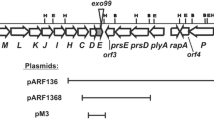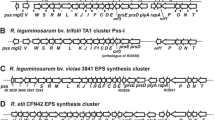Abstract
Pseudomonas sp. strain 267 isolated from soil promoted growth of different plants under field conditions and enhanced symbiotic nitrogen fixation in clover under gnotobiotic conditions. This strain produced pyoverdine-like compound under low-iron conditions and secreted vitamins of the B group. The role of fluorescent siderophore production in the beneficial effect of strain 267 on nodulated clover plants was investigated. Several non-fluorescent (Pvd-) Tn5 insertion mutants of Pseudomonas sp. strain 267 were isolated and characterized. The presence of Tn5 insertions was confirmed by Southern analysis of EcoRI digested genomic DNA of each derivative strain. The siderophore-negative mutants were compared to the parental strain with respect to their growth promotion of nodulated clover infected with Rhizobium leguminosarum bv. trifolii 24.1. We found that all isolated Pvd- mutants stimulated growth of nodulated clover plants in a similar manner to the parental strain. No consistent differences were observed between strain 267 and Pvd- derivatives strains with respect to their plant growth promotion activity under gnotobiotic conditions.
Similar content being viewed by others
References
Ahl P, Voisard C and Defago G 1986 Iron bound siderophores, cyanic acid, and antibiotics involved in suppression of Thielaviopsis basicola, by Pseudomonas fluorescens strain. J. Phytopathol. 116, 121–134.
Aznar R and Alcaide E 1992 Siderophores and related outer membrane proteins produced by pseudomonads isolated from cels and freshwater. FEMS Microbiol. Lett. 98, 269–276.
Bakker P A H M, Van Peer R and Schippers B 1991 Suppression of soil-borne plant pathogens by fluorescent Pseudomonas: mechanism and prospects. In Biotic Interaction and Soil-borne Diseases. Eds. A B R Beemster, G J Bollen, M Gerlach, M A Ruissen, B Schippers and A Tempel. pp 221–230. Elsevier, Amsterdam, the Netherlands.
Berg D E and Berg C M 1983 The procaryotic transposable element Tn5. Bio/Technology 1, 131–150.
Brown M E 1972 Plant growth promoting substances produced by microorganisms of soil and rhizosphere. J. Appl. Bacteriol. 35, 443–445.
Davison J 1988 Plant beneficial bacteria. Bio/Technology 6, 282–286.
Deryto M and Skorupska A 1992 Rhizobial siderophore as an iron source for clover. Physiol. Plant. 85, 549–553.
Deryto M and Skorupska A 1993 Enhancement of symbiotic nitrogen fixation by vitamin-secreting fluorescent Pseudomonas Plant and Soil 154, 211–217.
Gibson F and Magrath D I 1969 The isolation and characterization of hydroxamic acid (aerobactin) formed by Aerobacter aerogenes 62–1. Biochim. Biophys. Acta 192: 175–184.
Grimes H D and Mount M S 1987 Influence of Pseudomonas putida on nodulation of Phaseolus vulgaris. Soil Biol. Biochem. 6, 27–30.
Guerinot M L 1991 Iron uptake and metabolism in the rhizobia/legume symbioses. Plant and Soil 130, 199–209.
Hardy R W F, Holsten R D, Jackson E K and Burns C 1982 The C2H2-C2H4 assay for N2 fixation. Laboratory and field evolution. Plant Physiol. 43, 1185–1210.
Kloepper J W, Leong J, Teintze M and Schroth M N 1980 Enhanced plant growth by siderophores produced by plant growth-promoting rhizobacteria. Nature 286, 885–886.
Kloepper J W, Lifschitz R and Zablotowicz R M 1989 Free-living bacterial inocular for enhancing crop productivity. Trends Biotechnol. 7, 39–44.
Kloepper J W, Zablotowicz R M, Tipping E M and Lifshitz R 1991 Plant growth promotion mediated by bacterial rhizosphere. In The rhizosphere and plant growth. Eds. D L Keister and P B Cregan. pp 315–326. Kluwer Academic Publishers, Wageningen, the Netherlands.
Leong J 1986 Siderophores their biochemistry and possible role in the bio-control of plant pathogens. Annu. Rev. Phytopathol. 24, 187–209.
Loper J E and Lindow S E 1994 A biological sensor for iron available to bacteria in their habitats on plant surfaces. Appl. Environ. Microbiol. 60, 1934–1941.
Meyer J M and Abdallah M A 1978 The fluorescent pigment of Pseudomonas fluorescens: biosynthesis, purification and physicochemical properties. J. Gen. Microbiol. 107, 319–328.
Moreau S, Meyer J-M and Puppo A 1995 Uptake of iron by symbiosomes and bacteroids from soybean nodules. FEBS Letters 361, 225–228.
Neilands J B 1981 Microbial iron compounds. Annu. Rev. Biochem. 50, 715–731.
Polonenko D R, Scher F M, Kloepper J W, Singleton C A, Laliberte M and Zaleska I 1987 Effect of root colonizing bacteria on nodulation of soybean roots by Bradyrhizobium japonicum. Can. J. Microbiol. 33, 498–503.
Rodelas B, Salmeron V, Martinez-Toledo M V and Gonzalez-Lopez J 1993 Production of vitamins by Azospirillum brasilense in chemically-defined media. Plant and Soil 153, 97–101.
Sambrook J, Fritsch E F and Maniatis T 1989 Molecular Cloning, A Laboratory Manual. 2nd ed. Cold Spring Harbor Laboratory, Cold Spring Harbor, NY, USA.
Schippers B, Bakker A W and Bakker P A H M 1987 Interactions of deleterious and beneficial rhizosphere microorganisms and the effect of cropping practices. Annu. Rev. Phytopathol. 25, 339–358.
Schroth M N and Hancock J G 1981 Selected topics in biological control. Annu. Rev. Microbiol. 35, 453–476.
Schwyn B and Neilands J B 1987 Universal chemical assay for the detection and determination of siderophores. Anal. Biochem. 160, 47–56.
Simon R, Priefer V and Pühler A 1983 A broad host range mobilization system for in vivo genetic engineering: transposon mutagenesis in gram-negative bacteria. Bio/Technology 1, 784–791.
Skorupska A and Deryto M 1989 Siderophore production and utilization by Rhizobium trifolii. Biol. Metals 2, 45–49.
Verma D P S and Long S 1983 The molecular biology of Rhizobium-legume symbiosis. Int. Rev. Cytol. Suppl. 14, 211–245.
Vincent J M 1970 A manual for the Practical Study of Root Nodule Bacteria. IBP Handbook no. 5. Blackwell Sci. Publ, Oxford, UK.
Weller D M 1988 Biological control of soilborne plant pathogens in the rhizosphere with bacteria. Annu. Rev. Phytopathol. 26, 379–407.
Weller D M and Thomashow 1990 Antibiotics: evidence for their production and sites where they are produced. In New Directions in biological Control. Eds. R R Baker and P E Dunn. pp 703–711. Alan R Liss, Inc., New York, USA.
Zimmer W, Roeben K and Bothe H 1988 An alternative explanation for plant growth promotion by bacteria of the genus Azospirillum. Planta 176, 333–342.
Yoshikawa M, Hirai N, Wakabayashi K, Sugizaki H and Iwamura H 1993 Succinic and lactic acids as plant growth promoting compounds produced by rhizospheric Pseudomonas putida. Can. J. Microbiol. 39, 1150–1154.
Author information
Authors and Affiliations
Additional information
Dr Deryto died in august 1994
Rights and permissions
About this article
Cite this article
Marek-Kozaczuk, M., Deryto, M. & Skorupska, A. Tn5 insertion mutants of Pseudomonas sp. 267 defective in siderophore production and their effect on clover (Trifolium pratense) nodulated with Rhizobium leguminosarum bv. trifolii . Plant Soil 179, 269–274 (1996). https://doi.org/10.1007/BF00009337
Received:
Accepted:
Issue Date:
DOI: https://doi.org/10.1007/BF00009337




